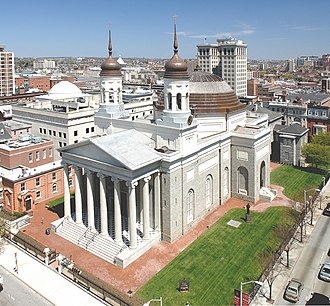Cathedral Hill Historic District | |
 Basilica of the Assumption | |
| Location | Baltimore, Maryland |
|---|---|
| Coordinates | 39°17′37″N76°36′58″W / 39.29361°N 76.61611°W |
| Area | 23 acres (9.3 ha) |
| Architect | Multiple |
| Architectural style | Late 19th And 20th Century Revivals, Mid 19th Century Revival, Late Victorian |
| NRHP reference No. | 87000622 [1] |
| Added to NRHP | April 27, 1987 |
The Cathedral Hill Historic District is an area in Baltimore, Maryland. It lies in the northern part of Downtown just south of Mount Vernon. Roughly bounded by Saratoga Street, Park Avenue, Hamilton Street, and St. Paul Street, these 10 or so blocks contain some of the most significant buildings in Baltimore. [2] The area takes its name from the Basilica of the Assumption which sits in the heart of the district. Despite the number of large religious structures in the area, the district's buildings are primarily commercial in character, with a broad collection of significant commercial structures ranging in date from 1790 to 1940. [3]
Contents
Cathedral Hill contains a mix of architectural styles from Georgian of St. Paul's Rectory [4] to Art Deco along Charles Street. The area was added to the National Register of Historic Places in 1987. [2] Cathedral Hill is within Baltimore National Heritage Area. [5]







